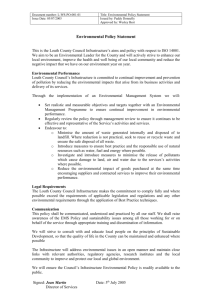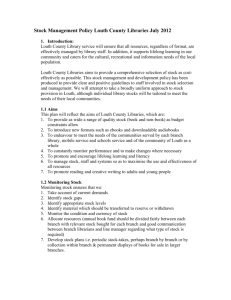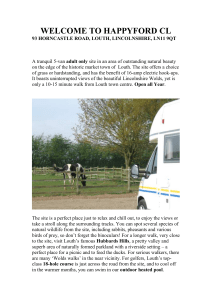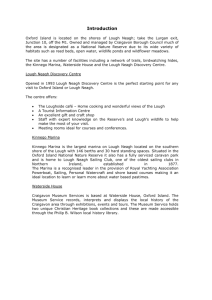Water Quality Improvement Plan
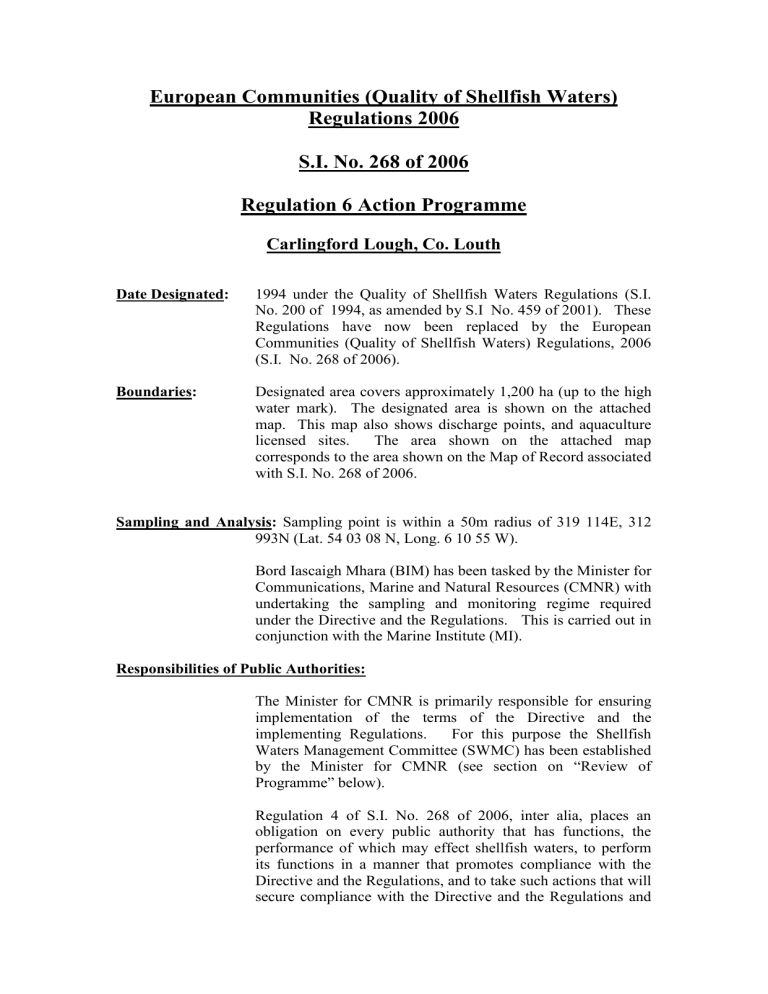
European Communities (Quality of Shellfish Waters)
Regulations 2006
S.I. No. 268 of 2006
Regulation 6 Action Programme
Carlingford Lough, Co. Louth
Date Designated: 1994 under the Quality of Shellfish Waters Regulations (S.I.
No. 200 of 1994, as amended by S.I No. 459 of 2001). These
Regulations have now been replaced by the European
Communities (Quality of Shellfish Waters) Regulations, 2006
(S.I. No. 268 of 2006).
Boundaries: Designated area covers approximately 1,200 ha (up to the high water mark). The designated area is shown on the attached map. This map also shows discharge points, and aquaculture licensed sites. The area shown on the attached map corresponds to the area shown on the Map of Record associated with S.I. No. 268 of 2006.
Sampling and Analysis: Sampling point is within a 50m radius of 319 114E, 312
993N (Lat. 54 03 08 N, Long. 6 10 55 W).
Bord Iascaigh Mhara (BIM) has been tasked by the Minister for
Communications, Marine and Natural Resources (CMNR) with undertaking the sampling and monitoring regime required under the Directive and the Regulations. This is carried out in conjunction with the Marine Institute (MI).
Responsibilities of Public Authorities:
The Minister for CMNR is primarily responsible for ensuring implementation of the terms of the Directive and the implementing Regulations. For this purpose the Shellfish
Waters Management Committee (SWMC) has been established by the Minister for CMNR (see section on “Review of
Programme” below).
Regulation 4 of S.I. No. 268 of 2006, inter alia, places an obligation on every public authority that has functions, the performance of which may effect shellfish waters, to perform its functions in a manner that promotes compliance with the
Directive and the Regulations, and to take such actions that will secure compliance with the Directive and the Regulations and
with this action programme. The “prescribed public authorities” are those listed in Schedule 1 to S.I. No. 268 of
2006 and are consulted by the Minister for CMNR in establishing and reviewing this action programme, and in investigating any instances where the designated waters fail to comply with mandatory standards. Some of the “prescribed public authorities” are also represented on the SWMC.
Description of Area: Carlingford Lough is a flooded river valley that lies on the east coast of Ireland in a steep valley between the Mourne
Mountains to the north, and Carlingford Mountains to the south, and straddling the border between Ireland and Northern
Ireland. The designated area extends to approx 1,200 of the loughs 4,000 ha. Average water depth in the lough is 5m and max depth is 35m. Tidal currents are strong (up to 2.5m/s), and the intertidal area is 1,490 ha, so that there is good water exchange at each tide.
The catchment of the lough is approx. 59,000 ha. It is a mix of forest, rough and improved grazing, and small areas of agricultural land, with the area further inland dominated by a mix of pasture, natural grassland, arable, moor and heath land.
The principal freshwater input is the Newry River, which straddles the border where it discharges into the head of the lough. The river has a flow rate range of 1-9m
3
/s depending on the season and the river quality is good to fairly good. Other rivers on the northern side of the Lough include the
Moygannon (very good water quality), the Rostrevor (no data), the White Water (very good water quality), the Ballincurry (no data) and the Ghann (very good water quality). These are spate rivers feeding down from the mountains. On the southern side of the Lough the Ryland is the only river of note but is too small to be listed by EPA for water quality.
Population:
There are no IPPC licenced activities in the area.
Marine activities in the area include sailing, diving, windsurfing and angling.
The population of the catchment is 30,460, The principal settlements are Newry City (pop. 21,633), Warrenpoint (5,408),
Rostrevor (2,200) and Greencastle (<100), all in Northern
Ireland. On the southern side of the lough and on the shore of the designated area are Carlingford (650), Omeath (300), and
Greenore (<100).
Sewage Collection Systems:
The Electoral Districts along the southern shore of the designated area of Carlingford Lough cover an area of 5,598 hectares. Within this area live 3,135 people of which 1,000 live in towns served by sewage collection systems.
Septic Tanks: The population of people not served by centralised sewage systems in the Electoral Districts bordering the designated area is approximately 2,135. This equates to an average population density of approximately 0.4 per hectare. The bedrock in the area is a mixture of sandstone and granite, which are described by the Geological Survey of Ireland as moderately productive aquifers.
Development: The area around Carlingford lough is a popular destination for tourists. As such there is pressure on the area in terms of accommodation and leisure activities and associated infrastructural needs.
Agriculture:
To have planning permission granted for one-off housing, it is necessary to show that the soil conditions on the site are suitable for the purpose. There must be adequate percolation to make the use of a septic tank efficient, and these tanks must be sited an adequate distance from water courses to minimise the risk of contamination of water bodies.
Livestock numbers within the catchment are approximately
15,000. Sheep numbers in the Border region have been reduced by 7% between 1995 and 2004, reducing their potential impact on water quality. Cattle numbers have increased by 2% in the same interval. With the advent of decoupling of headage payments sheep numbers are expected to fall further in the immediate future.
Shellfish Activity: Gigas oysters and bottom mussels are the most important shellfish species harvested within the Lough. There is also traditional winkle picking and some cockle raking and razor clam fishing takes place. The Irish Authorities have issued 18 shellfish licences within the Lough. The majority of these fall within the boundaries of the designated area. Annual production of mussels between 2000 and 2004 averaged 1840 tonnes, and of oysters was 440 tonnes.
Classification :
More generally, S.I. No. 788 of 2005 (European Communities
(Good Agricultural Practice for Protection of Waters)
Regulations 2005) will significantly enhance measures for the protection of waters from potential pollution from agriculture.
Shellfish beds in Carlingford Lough are classified ‘A’ (razor clams), ‘A’ and ‘B’ (oysters) and ‘B’ (mussels) in accordance with the European Communities (Live Bivalve Molluscs)
(Health Conditions for Production and Placing on the Market)
Regulations, 1996 (S.I. No. 147 of 1996).
Summary of Total Discharges (all types) in relevant catchment area relating to
Designated Shellfish Area .
Discharge Type No. Discharging directly into area
Untreated
Sewage
IPC
2
No. Discharging in a 5km radius
*
No. Discharging in a 5-10Km radius
*
No. Discharging in a 10-20Km radius
*
Section 4
Section 16
Treatment Plant
Drainage
Nil
2
Nil
1
Nil
*
*
*
*
*
*
*
*
*
*
*
*
*
*
*
Other Nil * *
* Data from Northern Ireland is required to complete this table
*
Assessment of Compliance
Results from sampling over the past 12 months shows that the area is in compliance for parameters 1-9. Organohalogen levels have been below the limit of detection.
100% of samples taken in the past twelve months recorded levels of faecal coliforms of less than 300 fcs per 100ml of flesh. The designated waters are therefore compliant.
Risks /Actions regarding Discharges
Type: Untreated Sewage
Discharge
Ref.
Omeath
Level of treatment
None
Pop. Equ.
/Volume
400
Responsible
Authority
Louth
County
Council
Risks/Actions and Timescale
Greenore None 200 Louth
County
Council
Issue: Lack of treatment and proximity of outfall to shellfish growing areas.
There are no proposals for a treatment plant at this stage.
Action: BIM to liaise with Louth Co
Co re ongoing monitoring data.
It is understood that Louth Co Co is drawing up a Brief to examine the need for a WWTP in Omeath. BIM to maintain contact with Louth Co Co and check on progress/outcome.
Issue: Lack of treatment and proximity of outfall to shellfish growing areas.
There are no proposals for a treatment plant at this stage.
Action: BIM to liaise with Louth Co
Co re ongoing monitoring data. No
Treatment and proximity of outfall to shellfish growing areas. BIM to liaise with Louth Co Co on monitoring data.
Type: Section 4
Discharge
Ref.
Prime
Leisure
Ltd.
Holiday
Village
Tain
Holiday
Village
Level of treatment
Primary
Secondary
Pop. Equ.
/Volume
600
500
Responsible
Authority
Louth
County
Council
Louth
County
Council
Risks/Actions and Timescale
Issue: The licencee has indicated that it proposes to upgrade the waste water treatment plant to secondary treatment.
Action: BIM to establish more precise details re upgrade and timeframe for carrying out this work.
Issue: Monitoring of conformity with licence parameters.
Action: BIM to liaise with Louth Co
Co on monitoring issue.
A new treatment plant is at the planning stage for this development.
Type: Waste Water Treatment Plant
Discharge
Ref.
Carlingford
Level of treatment
Secondary
Pop. Equ.
/Volume
1500
Responsible
Authority
Louth
County
Council
Risks/Actions and Timescale
Issue: A new secondary WWTP has been in operation since 2001.
Proximity of outfall pipe.
Action: BIM to liaise with Louth Co
Co re monitoring data.
Other Actions
Cross-border liaison with the competent authorities in Northern Ireland needs to be established so that the impacts/risks of discharges from Northern Ireland on the designated waters can be identified. SWMC to discuss approach to establishing contacts, what data/information exchange is required initially and ongoing and on a reciprocal basis.
Review the designation to reflect changes in aquaculture licencing in the bay in the recent past.
Continued monitoring of water quality on the designated area to ensure continued compliance.
Continued liaising between relevant agencies to ensure that information is up to date, accurate, and available to all interested parties.
Review of Programme
This action programme will be managed by the SWMC consisting of representatives of the Minister for Communications, Marine and Natural Resources, the Minister for the Environment, Heritage and Local Government, the Minister for Agriculture and
Food, BIM, the Environmental Protection Agency (EPA) and the M.I. Other public authorities, as relevant to the particular geographical area encompassed by the programme, may also be represented.
This programme will be reviewed every six months. Comments, suggestions etc. can be relayed to the Coastal Zone Management Division, Department of
Communications Marine and Natural Resources, Leeson Lane, Dublin 2, tel:
6782000, fax: 6782159, or e-mail foreshore@dcmnr.gov.ie.
Key:
IPPC – Integrated Pollution Prevention and Control Licence issued by the
Environmental Protection Agency under the Environmental Protection Agency Act,
1992.
Section 4 – a licence issued by the relevant local authority under Section 4 of the
Local Government (Water Pollution Act), 1977 for the discharge of trade effluent or sewage effluent to waters.
Section 16 - a licence issued by the relevant local authority under Section 16 of the
Local Government (Water Pollution Act), 1977 for the discharge of any trade effluent or other matter (other than domestic sewage or storm water) to a sewer.
CSO – Combined Storm Overflow.
WSIP – Water Services Investment Programme
DEHLG – Department of the Environment, Heritage and Local Government.
DCMNR – Department of Communications, Marine and Natural Resources.
26 May 2006
